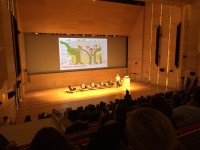The seventh annual Service Design Network Conference took place in New York on October 2-3, 2015, hosted at Parsons The New School. As a principal of the network, and the head of the SDN event board, I played a role in organizing the conference, moderated the opening panel, and helped keep everything running smoothly. Each year, new themes, questions, and insights emerge. Here are the ones that stood out to me.

People Need People
We live in an increasingly technological world, and often that means we lean heavily on technology to solve our challenges. Technology equals innovation, and innovation equals technology. Much service design work focuses on digital experiences only. A couple questions raised by attendees include: Are we in danger of defining service design as digital service design? Are we in danger of disenfranchising people? People still need people for reassurance and human connection. And service innovation can be void of technology, let’s not forget.
Small Agencies Under Siege
In 2014, the service design community was either shocked or inspired (or a bit of both) by Capital One’s acquisition of Adaptive Path. This was mentioned in several presentations. Some questioned whether this was the beginning of the end of small design agencies. What will happen as more organizations build internal service design functions? Will agencies be able to keep their talent? Will agencies be able to have as much impact as an internal team? (I have thoughts and experience with this, but will save that for another post.)
Discovery Focused vs Delivery Focused
This wasn’t widely discussed, but it hit a nerve with me. Much of service design work to date has been focused on discovery, research, ideation, and articulation of new service visions or elements. We don’t have many tools for service implementation and delivery. Can service design be both discovery focused and delivery focused? How can we get better at connecting the two? Jon Campbell from Continuum pointed out that most organizations overestimate their ability to implement. I completely agree. If we want to see our service visions implemented we need to focus more on service delivery. This will be a key arena for service design going forward.
What is a service designer?
During his talk, Mikal Hallstrup, Founder and Global CEO at Designit, stated, “I’m not a service designer.” His background is in product design. I also don’t call myself a service designer. But I do tell people I design services. My background is in interaction design. Many disciplines contribute to service design. Some people call themselves service designers. But what does that mean? What experience, background, or skills are required? Is a service designer that comes from a design background the same as one that comes from business and operations? If you want to open a debate, this is a good starter.
Nice Landing, Wrong Airport
While I understand the need to create a sense of urgency to get teams to move quickly and reach a goal, I often see the deadlines created to launch new features, products, and service experiences as arbitrary and counterproductive. So I loved this by Nick de Leon: “Delivering on time and on budget doesn’t move the dial for customers or the organization.” In other words, he said, “Nice landing, wrong airport.” Remember this the next time you’re rushing toward a deadline. What are you sacrificing to reach the deadline? What’s more important, the service experience or the deadline? Are you reinforcing positive organizational behavior?
No Overarching View
Sarah Brooks and Julia Kim from Veterans Affairs for the US Federal Government highlighted the need to have an overarching view of the service. Shockingly, most if not all organizations do not have a way to holistically look at the service they are providing. This means we patch over the existing system without really understanding the impacts upstream or downstream and end up with quite a mess. This long standing practice will ensure much service design work long into the future. It’s also why things like end-to-end journey maps, blueprints, and vision stories are mindblowingly innovative within most organizations.
Oncologies of Service
A couple speakers mentioned different oncologies of service, which connected with ideas I’ve had about creating a better categorization of services given the breadth of the service landscape. This is a model Terry Irwin and Cameron Tonkinwise from Carnegie Mellon University had in their presentation.
While I don’t think this captures everything, it’s simple and one way to think about types of services. Also, this provides a contrast to products.
Service Design is…
Here are a couple somewhat unconventional definitions of service design I noted.
“Service design is a restructuring of how society cares about people.” – Cameron Tonkinwise
“Service design is a path of embracing change to create value.” – Cathy Huang, CBi China Bridge
Service Design Aims at Government
Paul Thurston and Anna Whicher of PDR pointed out that 28 percent of the SDN conference speakers came from the public sector. They noted that in the UK, service design is being applied to government contracts, and design skills are being written into government job posts. Here in the US, we also have more design being focused on government. Presenters Sarah Brooks with Veteran Affairs and Chelsea Mauldin from the Public Policy Lab are two examples. 18F, not present at the conference, is another. This is more evidence that one day service design will be business as usual.
You can view slide and find videos on the SDN website, or read a summary of each talk at Design For Service.





Comments
One response to “Themes from Service Design Network Conference New York”
I love the “Nice Landing, Wrong Airport” analogy! I’d love to hear more about the oncologies though, specific arguments for different viewpoints.